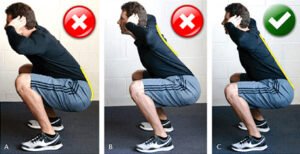Squats are a powerful exercise that can work wonders for your body, boosting strength, stability, and flexibility. But like any physical activity, they come with their risks and downsides when not done correctly. One common issue many fitness enthusiasts face is lower back pain from squats. This blog post will dive into the crucial link between squats and lower back pain, offering insights into prevention and management techniques to help you keep smashing your fitness goals without compromise.
Contents
Is It Common To Have Lower Back Pain From Squats?
 Yes, it is not uncommon for individuals to experience lower back pain from squats. Particularly if they are not performed with proper form. Squats are compound movements that require the engagement of multiple muscle groups, including your lower back. It will help to stabilize your body throughout the exercise. When done correctly, squats can actually help to strengthen your lower back and reduce the risk of injury.
Yes, it is not uncommon for individuals to experience lower back pain from squats. Particularly if they are not performed with proper form. Squats are compound movements that require the engagement of multiple muscle groups, including your lower back. It will help to stabilize your body throughout the exercise. When done correctly, squats can actually help to strengthen your lower back and reduce the risk of injury.
However, incorrect form, excessive weights, or pre-existing back issues can lead to strain or injury in the lower back region. Often, lower back pain from squats is a result of rounding or over-arching the back, not keeping the core engaged, or allowing the knees to collapse inwards. The load of the weight, which should ideally be supported by your glutes and quadriceps, can then fall disproportionately onto your lower back. This ultimately leads to discomfort or pain.
What Squatting Mistakes Lead To Lower Back Pain?
Several squatting mistakes can lead to lower back pain. Understanding and rectifying these errors can help you avoid discomfort and injury, ensuring you reap the full benefits of this potent exercise. Here are some common mistakes:
- Poor Form
One of the most common issues is maintaining improper form during the squat. This could be due to rounding the back (a “butt wink”), or excessively arching the lower back. Both positions can strain the lower back muscles and spinal discs.
- Excessive Weight
Lifting weights that are too heavy for your current strength levels can cause you to compromise your form. This will lead to undue stress on the lower back. It’s always better to use a manageable weight and gradually increase as your strength improves.
- Incorrect Bar Position
The position of the barbell during a back squat can also affect your lower back. If the bar is too high or too low, it could throw off your balance or force you to lean too far forward or backward, straining your lower back.
- Lack of Core Engagement
Your core muscles help to stabilize your body during a squat. If your core is not engaged, your lower back will take on more strain to compensate for the lack of stability.
- Limited Mobility
If you lack mobility in your hips or ankles, it can alter your squatting form. This might force you to lean too far forward, which can put extra stress on your lower back.
- Allowing Knees to Cave
If your knees cave inwards during a squat (a problem known as valgus collapse), it can throw off your alignment and place more stress on the lower back.
- Not Warming Up
Warming up increases blood flow to the muscles and improves flexibility, reducing the risk of injury. If you jump straight into heavy squats without a proper warm-up, you can easily strain your lower back.
How Do You Fix Lower Back Pain From Squats?
 Fixing lower back pain from squats usually involves a combination of improving your technique, strengthening your core and lower body, and implementing proper recovery techniques. Here are some strategies that can help:
Fixing lower back pain from squats usually involves a combination of improving your technique, strengthening your core and lower body, and implementing proper recovery techniques. Here are some strategies that can help:
Improve your form
The correct form is vital when performing squats to prevent unnecessary strain on your lower back. This means maintaining a neutral spine, engaging your core, and ensuring your knees are tracking over your feet throughout the movement. A neutral spine refers to the natural curvature of the spine, neither overly arched nor excessively rounded.
When engaging your core, imagine pulling your belly button toward your spine. As this action helps to stabilize your trunk and protect your back. As for knee alignment, your knees should be in line with your second toe on each foot during the squat to avoid undue lateral pressure on the knee joint.
Gradually Increase Weight
It can be tempting to lift heavy weights, especially if you’re trying to build strength or muscle mass. However, adding too much weight too soon can compromise your form and lead to injury. Instead, start with a weight that allows you to perform the squat with proper form and complete your desired number of repetitions. As your strength and form improve, gradually add more weight. It will ensure that you can maintain proper form even as the weight increases.
Strengthen Your Core
A strong core can provide the necessary support for your spine during a squat, helping to distribute the load evenly and minimize strain on your lower back. Core exercises go beyond just traditional crunches. Try exercises like planks, bridges, and bird dogs to work your entire core, including the deeper muscles that are essential for stability. As your core strength improves, you should notice better control and stability during your squats.
Improve Mobility
If you lack mobility in your hips or ankles, your squat form may suffer, and you may put undue stress on your lower back. To enhance your hip mobility, try exercises like hip circles, leg swings, and lunges. Ankle mobility can be improved with exercises like ankle circles, calf stretches, and downward dog. Implementing a regular stretching or yoga routine can also help increase overall flexibility. And leading to improved form and less strain on the lower back during squats.
Warm-Up Properly
A proper warm-up is essential before any exercise, including squats. A warm-up serves several purposes: it gradually raises your body temperature, increases blood flow to your muscles, improves joint mobility, and mentally prepares you for the workout ahead. Failing to warm up properly can increase the risk of injury and limit your performance. For squats, a good warm-up might include 5-10 minutes of light aerobic activity, like jogging or cycling, followed by dynamic stretches focusing on the lower body.
Rest and Recovery
If you’re experiencing lower back pain after squats, it’s crucial to give your body time to rest and recover. Overworking your muscles can lead to fatigue and injury. So make sure you’re allowing for adequate recovery time between intense squatting sessions. Techniques like applying ice or heat to the affected area can help reduce inflammation and soothe sore muscles. Gentle stretching and foam rolling can also aid in recovery by improving blood flow and flexibility.
Professional Help
If your pain continues even after you’ve improved your form, reduced weight, strengthened your core, increased your mobility, and incorporated proper rest and recovery, it may be time to seek professional help. A physical therapist can assess your situation and guide you through targeted exercises and treatments to address your specific issue. They can also provide advice on how to modify your squat technique or suggest alternative exercises to maintain your fitness without exacerbating your lower back pain.
In more severe cases, it may be necessary to consult with a medical doctor or a specialist for a more comprehensive evaluation and treatment plan. Remember, persistent pain is a signal from your body that something is wrong, and it’s essential not to ignore it.
Should I Stop Squatting If My Lower Back Hurts?
 If you’re experiencing lower back pain while squatting or shortly afterward, it’s a good idea to stop the exercise to prevent further strain or potential injury. Lower back pain can indicate that you’re not performing the exercise correctly. That you’re lifting more weight than your body can handle, or that there’s an underlying issue that needs to be addressed. Continuing to squat under these conditions can worsen the situation and potentially lead to more serious injuries.
If you’re experiencing lower back pain while squatting or shortly afterward, it’s a good idea to stop the exercise to prevent further strain or potential injury. Lower back pain can indicate that you’re not performing the exercise correctly. That you’re lifting more weight than your body can handle, or that there’s an underlying issue that needs to be addressed. Continuing to squat under these conditions can worsen the situation and potentially lead to more serious injuries.
However, stopping doesn’t necessarily mean you should completely avoid squats forever. After you’ve allowed your body to rest and recover. Then, consider seeking guidance from a physical therapist, a trainer, or another fitness professional. They can help you correct any form errors, build your strength and mobility, and gradually reintroduce squats into your routine in a safe and effective way.
Squats are a highly beneficial exercise when done correctly. So the goal should generally be to modify and adapt the exercise, rather than eliminate it entirely.
Conclusion
In conclusion, experiencing lower back pain from squats is not uncommon. But it’s a signal that shouldn’t be ignored. Whether it’s due to improper form, excessive weight, weak core muscles, or limited mobility, recognizing and rectifying these issues can significantly reduce your risk of back pain. Remember to warm up properly before your workout and give your body enough time to recover afterward. If pain persists despite your best efforts, seeking professional help is advisable to prevent further strain or injury.
Ultimately, squats are a fantastic full-body exercise that, when performed correctly, can help build strength, improve balance, and contribute to overall fitness. With attention to form and respect for your body’s signals, you can make squats a beneficial part of your regular fitness routine.
If you’re experiencing Back pain, physical therapy for back pain at PhysioMantra can help: Book an online physical therapy session.



